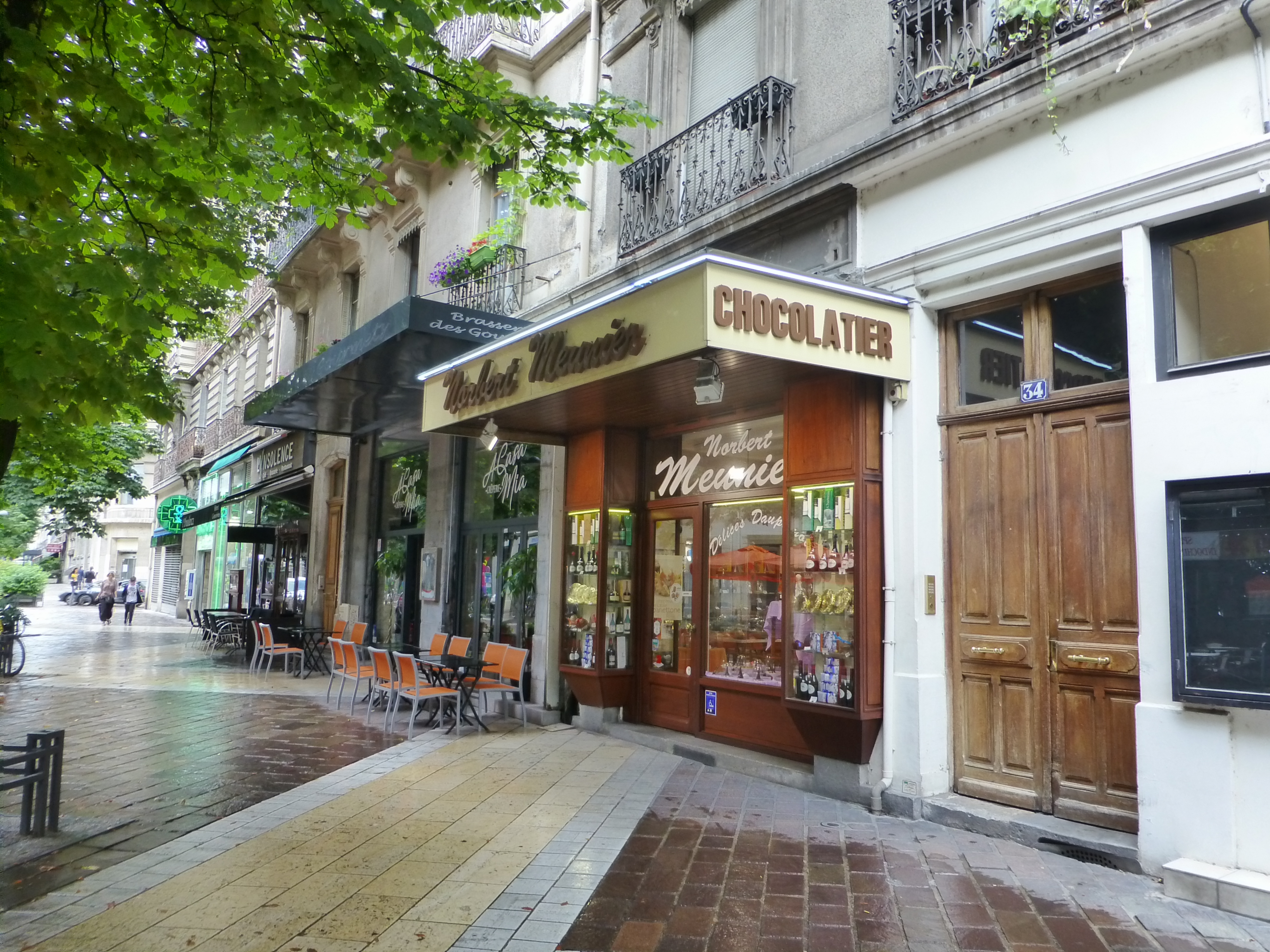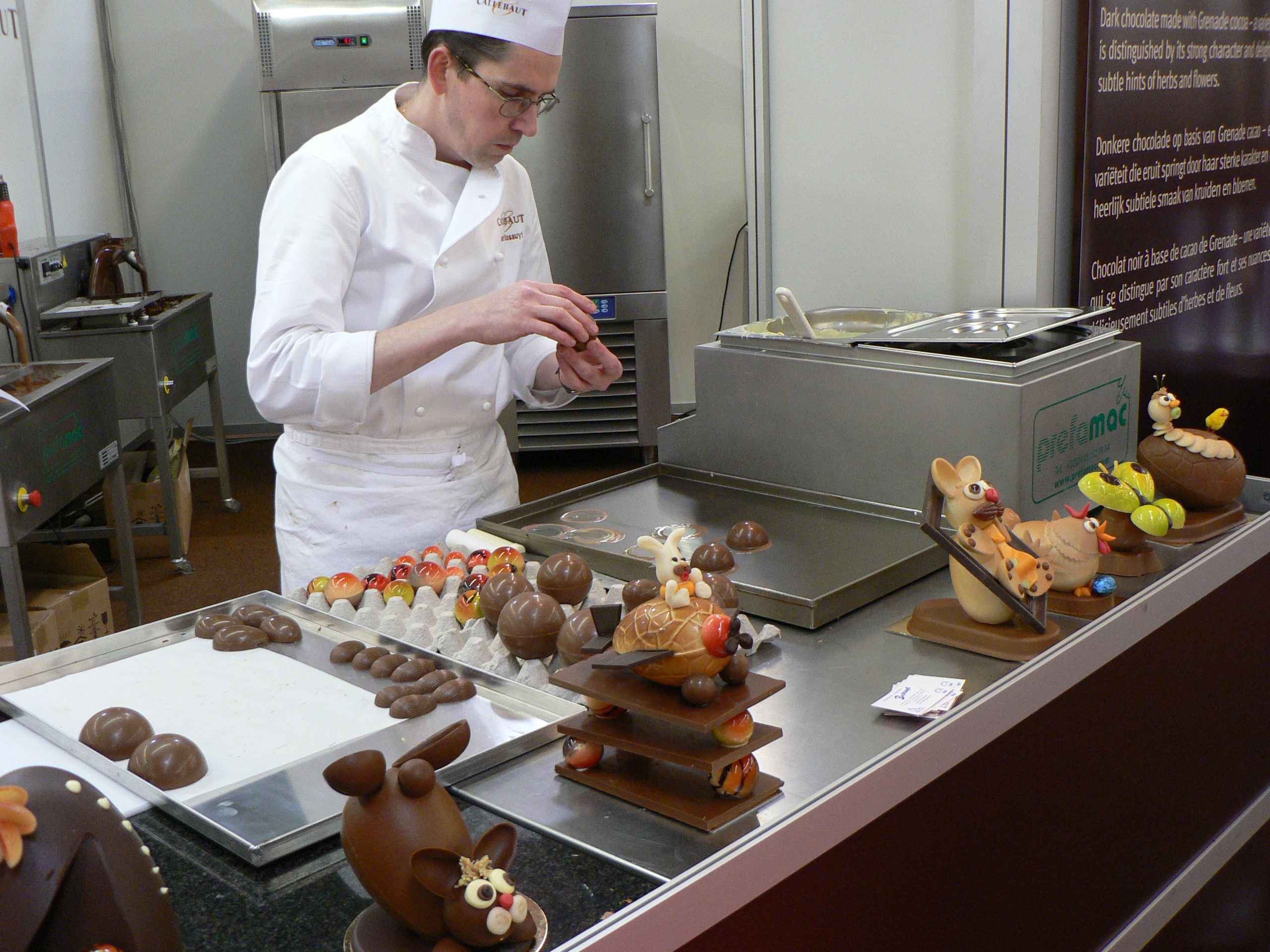Chocolatier on:
[Wikipedia]
[Google]
[Amazon]

 A chocolatier ( ; ; ) is a person or company that makes and sells chocolate confections. Chocolatiers are distinct from chocolate makers, who create chocolate from
A chocolatier ( ; ; ) is a person or company that makes and sells chocolate confections. Chocolatiers are distinct from chocolate makers, who create chocolate from
Movie page
Observations from the annual
table of contents by ORF
(Memento from August 14, 2014, in internet archive).

cacao bean
The cocoa bean, also known as cocoa () or cacao (), is the dried and fully fermented seed of ''Theobroma cacao'', the cacao tree, from which cocoa solids (a mixture of nonfat substances) and cocoa butter (the fat) can be extracted. Cacao trees ...
s and other raw ingredients. Chocolatiers work artisanally with pre-made chocolate mass. Within the chocolate industry, chocolatiers are sometimes referred to derisively as "melters". Chocolatiers are often trained as pastry chefs or confectioners specializing in chocolate and making chocolate candies.
In the food industry
The food industry is a complex, global network of diverse businesses that supplies most of the food consumed by the world's population. The food industry today has become highly diversified, with manufacturing ranging from small, traditional, ...
, food technologists or food technology engineers (FH) develop chocolate products for large, well-known chocolate brands. For the industrial production of chocolate and chocolate products, a three-year training course has been set up in Germany to train people as specialists in confectionery technology. The Central Technical School of the German Confectionery Industry (ZDS) in Solingen
Solingen (; ) is a city in North Rhine-Westphalia, Germany, 25 km east of Düsseldorf along the northern edge of the Bergisches Land, south of the Ruhr. After Wuppertal, it is the second-largest city in the Bergisches Land, and a member of ...
offers further education and training.
Education and training
Chocolatiers must understand the physical and chemical aspects of chocolate to create chocolate confections, sculptures, and centerpieces. Perfecting the technical aspects of chocolate design and developing the art of flavor takes many years of training and practice. To become a chocolatier, a person must first learn how to make chocolate confections. Training usually begins with how to make chocolate confections from a variety of ingredients. As training progresses, students learn techniques for creating tasty handmade works of art. Some of these techniques include tempering, sculpting, and melting. Once trainees understand the physical and chemical aspects of making chocolate, they can work with chocolate in many different applications. Because chocolate is a versatile material, various courses teach different techniques to processing chocolate. Only when you are well trained in all uses of chocolate or have specialized in a specific application are you considered a chocolatier. Continuing education and taking courses about the craft of chocolate can lead to a better understanding of the ingredients of chocolate and how sculpting can be used to create amazing chocolate masterpieces. Traditionally, chocolatiers, especially in Europe, are trained through anapprenticeship
Apprenticeship is a system for training a potential new practitioners of a trade or profession with on-the-job training and often some accompanying study. Apprenticeships may also enable practitioners to gain a license to practice in a regulat ...
with other chocolatiers. It is now common for chocolatiers to start out as pastry or confectionery chefs, or attend culinary training specifically for working with chocolate. Being a master chocolatier involves perfecting the art of working with chocolate to create desserts and artistic displays.
Culinary schools
There are a variety of culinary schools and specialty chocolate schools, including the Ecole Chocolat Professional School of Chocolate Arts in Canada, and The Chocolate Academy by Callebaut, with over 20 different schools around the world. The International Culinary Center (formerly known as the French Culinary Institute) offers pastry and confectionery courses that help aspiring chocolatiers learn the trade. Programs of study at such institutions can include a variety of topics: * Thehistory of chocolate
The history of chocolate dates back more than 5,000 years, when the Theobroma cacao, cacao tree was first domesticated in present-day southeast Ecuador. Soon after domestication, the tree was introduced to Mesoamerica, where cacao drinks gained ...
* Modern techniques of cultivation and processing
* The chemistry of chocolate's flavors and textures
* Chocolate tempering, dipping, decorating, and molding
* Confectionery formulae based on ganache and/or fondant
* Business management skills including marketing and production
Techniques
* Tempering: Tempering chocolate involves heating and cooling the chocolate to result in desired characteristics like shininess of the chocolate or 'snap' (the way it breaks). Chocolate containscocoa butter
Cocoa butter, also called theobroma oil, is a pale-yellow, edible Vegetable oil, fat extracted from the cocoa bean (''Theobroma cacao''). It is used to make chocolate, as well as some ointments, toiletries, and pharmaceuticals. Cocoa butter h ...
which crystallizes during the heat treatment of melting and tempering chocolate. Heating the chocolate at certain temperatures for specific periods of time and then cooling the chocolate and working with it in alternating segments is referred to as tempering. It is important to note that the specific temperatures for chocolate tempering depend strongly on the type of chocolate being worked with (i.e. milk chocolate, white chocolate, dark chocolate, etc.).
*Molding: Molding is a design technique used in making chocolate pieces that are of a certain shape by taking liquid chocolate and pouring it into a mold and letting it harden.
*Sculpting
Sculpture is the branch of the visual arts that operates in three dimensions. Sculpture is the three-dimensional art work which is physically presented in the dimensions of height, width and depth. It is one of the plastic arts. Durable sc ...
: Sculpting involves shaping chocolate to create a piece of artwork. Sculpting may involve using molds, sculpting tools (such as spatulas or carving tools), and pieces of chocolate, and decorating the piece with designs in chocolate.
Additional techniques include dipping and decorating chocolate.
Competitions
Once a chocolatier has mastered the artistry of chocolate, they may be considered a Master Chocolatier. The best of these compete in The World Chocolate Masters, a chocolate competition that started in 2005. The World Chocolate Masters competition is held every three years in Paris, France. At the competition, the world's top chocolate masters craft a chocolate masterpiece to be judged by a jury. Leading chocolatiers include Naomi Mizuno (Japan), Francisco Torreblanca (Spain), Pierre Marcolini (Belgium), Yvonnick Le Maux (France), and Carmelo Sciampagna (Italy). Mizuno won the World Chocolate Masters competition in 2007. The competition was judged in four different categories: molded pralines, hand-dipped pralines, gastronomic chocolate dessert, small chocolate showpiece, and creative chocolate showpiece. At 28, Mizuno was the youngest competitor from his nation. He is employed at Futaba Pastry. Another well-known chocolate competition is the International Chocolate Awards. This competition was founded in 2012. The International Chocolate Awards holds regional competitions in many countries around the world. The winners of the regional competitions later attend the World Final to compete amongst the best chocolatiers from other regions.Literature
* Chantal Coady: Schokolade. Das Handbuch für Genießer. Taschen Verlag, Cologne 1998, . (Presents the leading chocolatiers throughout Europe on two pages each). *Pierre Hermé
Pierre Hermé (; born 20 November 1961) is a French pastry chef and chocolatier. He began his career at the age of 14 as an apprentice to Gaston Lenôtre. Called "the Picasso of Pastry" by ''Vogue'', Hermé was awarded the title of World's Best ...
, Danielle Monteaux: ''Carrément Chocolat.'' Agnès Viénot Éditions, Paris 2009, .
* Ewald Notter: ''Handwerk Schokolade: Techniken – Rezepturen – Schaustücke.'' Matthaes Verlag, Stuttgart 2013, .
* Oriol Balaguer: ''Obsession.'' Matthaes Verlag, Stuttgart 2016, .
* Fabian Rehmann: ''Bean to Bar: Von der Kakaobohne zur Schokoladentafel. Praxisbuch.'' Leopold Stocker Verlag, Graz, Stuttgart 2019, .
Movies
* ''Kings of Pastry''. Documentary, USA, France, 2009, 87 min, Director: Chris Hegedus, D.A. Pennebaker, Production: Pennebaker Hegedus FilmsMovie page
Observations from the annual
Meilleur Ouvrier de France
''Meilleur Ouvrier de France'' (MOF) is a competition for craftsmen held in France every four years. The winning candidates receive a medal.
Description
The title of ''Meilleur Ouvrier de France'' is a unique and prestigious award in France, a ...
(M.O.F.) competition in France and others during the production of the fragile chocolate showpieces under tension and with the participation of the judges.
* ''Schokoland Salzburg. Die Kunst der Verführung.'' Documentary film, Austria, 2014, 22:40 min., written and directed by: Matthias Vogt, production: ORF, first broadcast: August 8, 2014 in ORF III
ORF III (''ORF drei'', ''Österreichischer Rundfunk 3''), sometimes called ORF 3 is an Austrian television channel owned by the Austrian national broadcaster, Österreichischer Rundfunk (ORF). The channel launched on 26 October 2011 at 14:00 CE ...
, series: Our Austriatable of contents by ORF
(Memento from August 14, 2014, in internet archive).
References
External links
{{portal bar, Food Artisans Chocolate